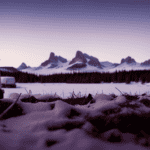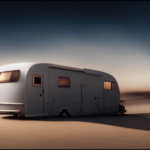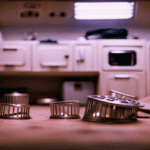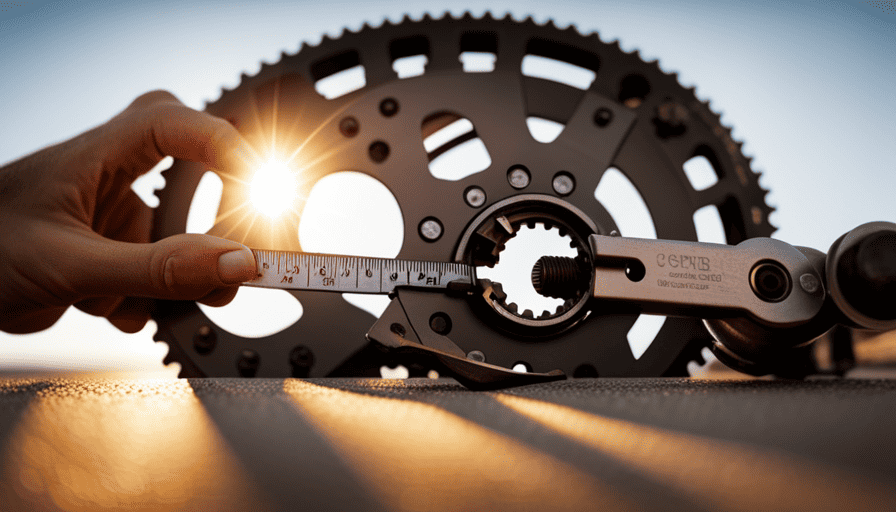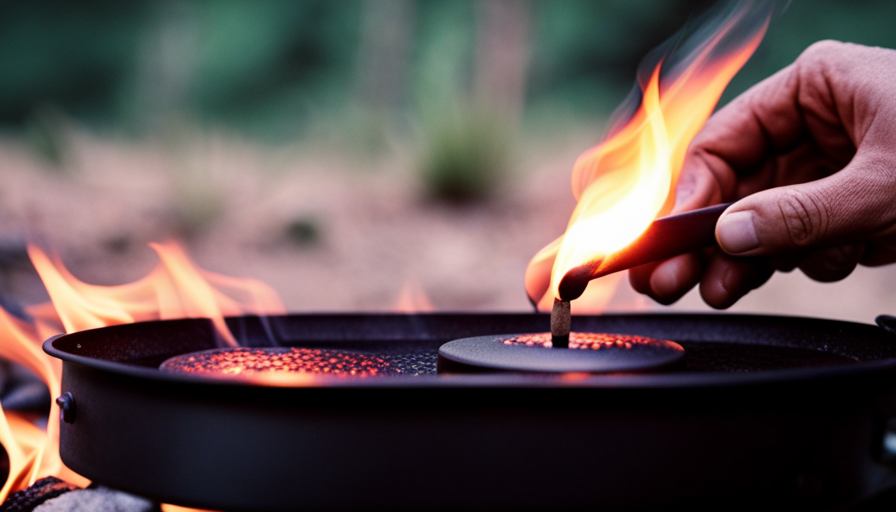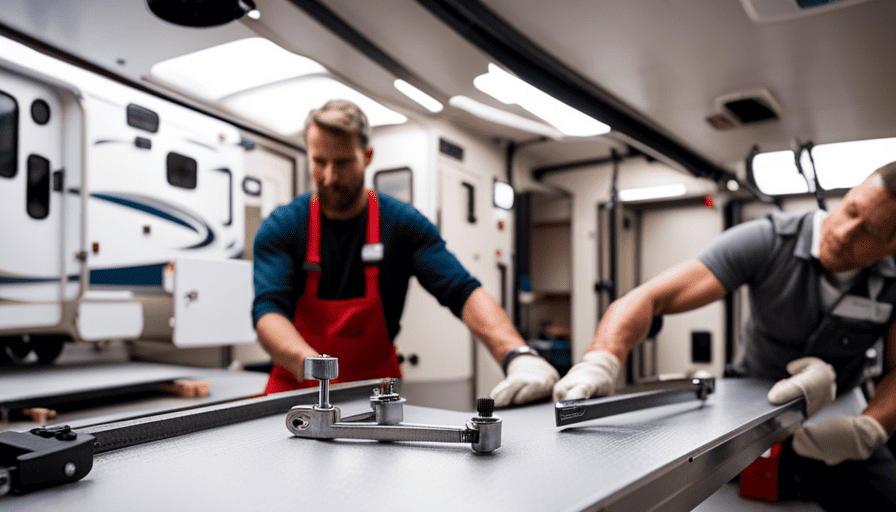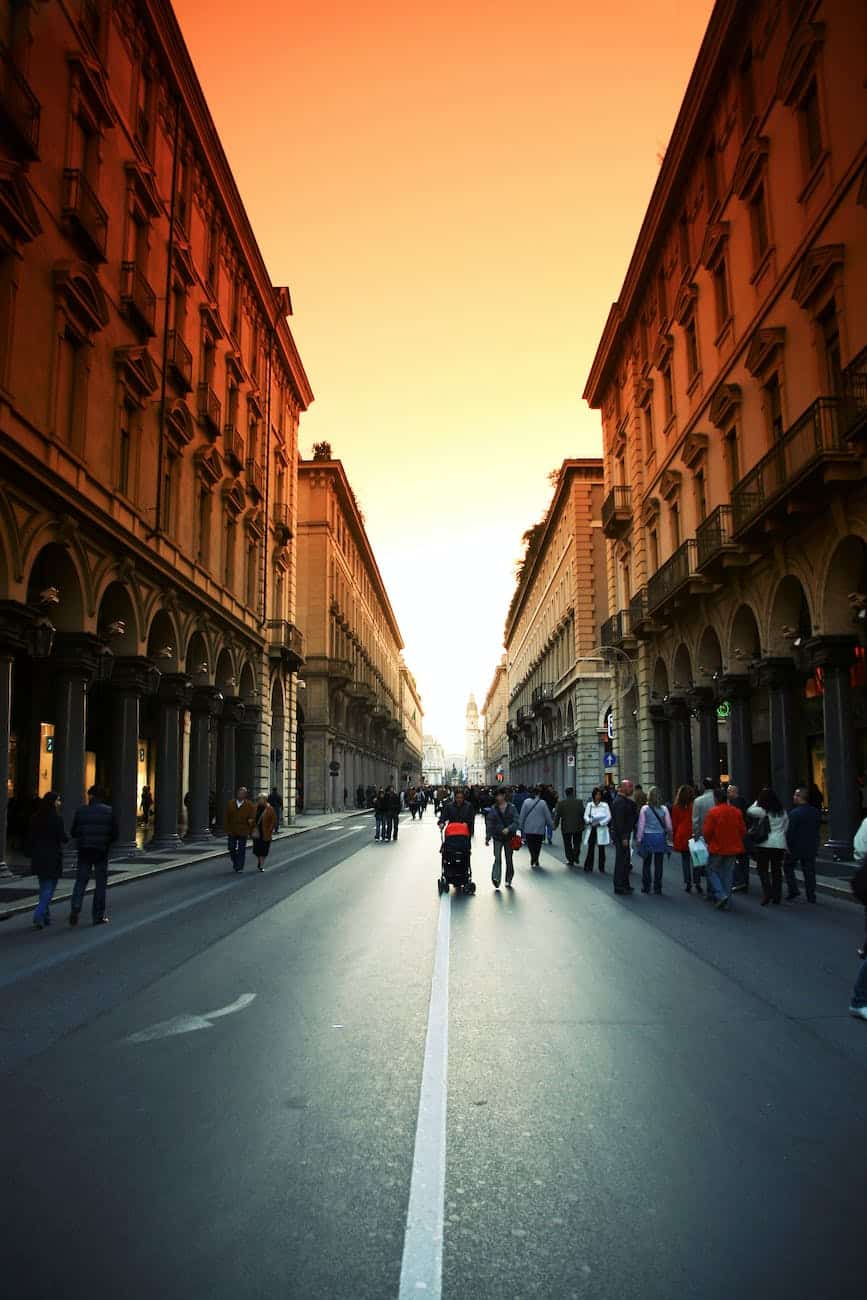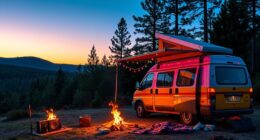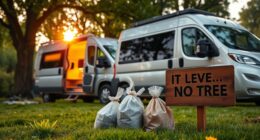Have you ever walked into your RV and been hit with a strong odor that nearly knocks you over? I have experienced this unpleasant situation before, and let me tell you, it’s not fun. The culprit? Mice. Despite their cute appearance, these small creatures can create a foul smell that lingers for weeks if not dealt with properly.
Lucky for you, I’ve got some tips and tricks up my sleeve to help you get rid of that mouse smell in no time.
In this article, I’m going to show you step-by-step how to eliminate that pesky mouse odor from your camper. We’ll start by removing any mouse droppings and nests, then move on to cleaning and disinfecting the entire space. I’ll also share some natural odor absorbers that can help freshen up the air, as well as tips for deep cleaning fabrics and upholstery. And don’t worry, we’ll cover preventive measures to keep those mice from coming back.
So, grab your cleaning supplies and get ready to say goodbye to that mouse smell once and for all!
Key Takeaways
- Properly remove mouse droppings and nests using gloves and disposable cloths.
- Sanitize surfaces with a bleach and water solution, followed by warm, soapy water.
- Use natural odor absorbers like baking soda and activated charcoal to eliminate odors.
- Take preventive measures to avoid future mouse infestations, such as sealing entry points and keeping the camper clean and free of food sources.
Remove Mouse Droppings and Nests
To effectively remove mouse droppings and nests from your camper, you’ll need to gather protective gear such as gloves and a mask, ensuring your safety as you tackle this task. Mice can leave behind droppings and build nests in hidden corners and crevices of your camper, so it’s important to thoroughly clean and sanitize these areas.
Start by removing any visible droppings with a paper towel or disposable cloth, being careful not to spread them around. Dispose of the droppings in a sealed bag.
Next, locate and remove any nesting materials, such as shredded paper or fabric, using gloves to protect yourself from potential bacteria or parasites.
Once you have removed the droppings and nests, it’s time to sanitize the surfaces. Mix a solution of bleach and water, using one part bleach to nine parts water, and apply it to the affected areas. Let the solution sit for a few minutes to ensure it kills any remaining bacteria. Afterward, wipe down the surfaces with a clean cloth and warm, soapy water to remove any remaining residue.
With the mouse droppings and nests removed and the camper surfaces sanitized, you can now move on to the next step of cleaning and disinfecting the entire camper, ensuring a fresh and odor-free environment.
Clean and Disinfect the Camper
Freshen up your camper by thoroughly cleaning and disinfecting every inch. To eliminate any traces of mouse smell, it is crucial to use the right cleaning supplies and techniques. Start by gathering the necessary materials, such as gloves, a mask, paper towels, a bucket, mild detergent, and a disinfectant.
To ensure a deep clean, create a cleaning solution by mixing the mild detergent with warm water in the bucket. Use this mixture to wipe down all surfaces, paying special attention to areas where mice may have left droppings or urine. Scrub any stains or residue until they are completely gone.
For added protection against bacteria and viruses, follow up with a disinfectant spray or wipe. This will help eliminate any remaining odors and ensure a sanitary environment. If the smell persists or if you prefer professional assistance, consider contacting a cleaning service that specializes in odor removal.
Now that your camper is clean and odor-free, it’s time to move on to the next step: using natural odor absorbers.
Use Natural Odor Absorbers
Now it’s time for you to try using natural odor absorbers to keep your camper smelling fresh. Natural odor absorbers are a great alternative to chemical-based products and can be easily made at home.
Here are two DIY odor eliminators that you can try:
-
Baking Soda: Baking soda is a powerful natural deodorizer that can effectively absorb odors. Simply sprinkle baking soda on carpets, upholstery, and other surfaces in the camper. Let it sit for a few hours or overnight, and then vacuum it up. You can also place an open box of baking soda in different areas of the camper to absorb odors continuously.
-
Activated Charcoal: Activated charcoal is another excellent natural odor absorber. It works by trapping odorous particles in its porous surface. You can place small bags filled with activated charcoal in various corners of the camper or near sources of odor, such as the kitchen or bathroom. Remember to replace the charcoal bags every few months for maximum effectiveness.
Using these natural odor absorbers will help eliminate unpleasant smells and keep your camper smelling fresh. Once you’ve tackled the odor issue, it’s time to move on to ventilating the camper to ensure proper airflow.
Ventilate the Camper
Properly ventilating your camper is essential for maintaining a fresh and airy environment. To improve air circulation, open all windows and doors to allow for a natural flow of air. This will help to eliminate any lingering mouse smell and replace it with fresh air.
Additionally, consider using air purifiers to further enhance the air quality inside the camper. These devices work by trapping and neutralizing odor-causing particles, leaving behind a clean and pleasant scent.
When ventilating your camper, it’s important to pay attention to the weather conditions outside. If it’s a sunny and breezy day, take advantage of the natural airflow by opening windows on opposite sides of the camper. This will create a cross-ventilation effect, effectively dissipating any unwanted odors.
On days when the weather isn’t cooperative, you can also use fans strategically placed near windows or vents to promote air circulation.
By improving the air circulation inside your camper and using air purifiers, you can effectively get rid of the mouse smell. However, if you want to take it a step further, you can also use odor eliminating sprays or fresheners. These products can help to mask any remaining odors and leave your camper smelling clean and inviting.
With proper ventilation and the right odor eliminating techniques, you’ll have a camper that smells fresh and enjoyable, ready for your next adventure.
Use Odor Eliminating Sprays or Fresheners
To effectively eliminate odors in your camper, consider using odor eliminating sprays or fresheners for a refreshing and inviting scent. Here are four ways to use sprays and fresheners to get rid of that pesky mouse smell:
-
Use air purifiers: These devices work by actively filtering the air in your camper, trapping and neutralizing odors. They can be especially effective in enclosed spaces like campers, where odors can linger.
-
Spray the affected areas: Be sure to thoroughly spray all surfaces where the mouse smell is present, including upholstery, curtains, and carpets. This will help to neutralize the odor and leave a fresh scent behind.
-
Place fresheners strategically: Consider using scented sachets or hanging fresheners in areas where the odor is particularly strong. This can help to mask the smell and leave your camper smelling clean and inviting.
-
Consider professional cleaning services: If the mouse smell persists even after trying sprays and fresheners, it may be time to call in the professionals. They have specialized equipment and products that can effectively eliminate stubborn odors.
By using odor eliminating sprays or fresheners, you can significantly improve the smell of your camper. However, if the mouse smell still lingers, it might be time to try baking soda or vinegar.
Try Baking Soda or Vinegar
Using baking soda or vinegar can work wonders in banishing those lingering odors and leaving your camper smelling fresh as a daisy. These household staples are not only affordable but also effective in neutralizing unpleasant smells. If you don’t have baking soda on hand, there are alternative options you can try. One popular alternative is activated charcoal, which absorbs odors and moisture. Simply place a few charcoal briquettes in an open container and leave them in your camper overnight. Another alternative is coffee grounds, which can help absorb and mask odors. Spread dry coffee grounds on a baking sheet and leave them in your camper for a few days. As for vinegar alternatives, lemon juice can be a great substitute. Its acidic properties help eliminate odors and leave a refreshing scent behind. Mix equal parts lemon juice and water, then spray the solution on surfaces in your camper. Now that we’ve tackled the odor problem, let’s move on to deep cleaning fabrics and upholstery to ensure a truly fresh and clean environment.
Deep Clean Fabrics and Upholstery
Now it’s time to roll up your sleeves and give those fabrics and upholstery a deep clean in order to achieve a truly fresh and clean environment in your camper. Start by tackling the carpets. Vacuum thoroughly to remove any loose dirt or debris.
Then, mix a solution of warm water and a mild carpet cleaner. Using a scrub brush or sponge, work the solution into the carpet, focusing on any stains or high traffic areas. Rinse with clean water and use a wet/dry vacuum to extract as much moisture as possible. Allow the carpets to air dry completely.
Next, turn your attention to the upholstery. Check the care labels on your furniture to determine the appropriate cleaning method. For most fabrics, a mixture of warm water and mild detergent should suffice. Dip a clean cloth into the solution and gently blot the stains, being careful not to saturate the fabric. If the stains persist, you can try using a fabric stain remover. Again, be sure to rinse with clean water and remove excess moisture.
To transition into the next section about using charcoal or activated carbon, remember that deep cleaning your fabrics and upholstery is essential, but it’s also important to eliminate any lingering odors.
Use Charcoal or Activated Carbon
One effective way to freshen up your camper is by using charcoal or activated carbon, which can work like a breath of fresh air for your fabrics and upholstery.
Charcoal and activated carbon are both natural odor absorbers commonly used to eliminate unwanted smells. While they have similar properties, there are some differences between the two.
-
Charcoal: Charcoal is made by heating wood or other organic materials in the absence of oxygen. It has a porous structure that allows it to trap and absorb odors effectively. Charcoal is readily available and affordable, making it a popular choice for odor removal. It can be used in a variety of forms, such as briquettes or activated charcoal powder.
-
Activated Carbon: Activated carbon is a processed form of charcoal that has been treated to increase its surface area. This treatment creates numerous tiny pores that enhance its odor-absorbing capabilities. Activated carbon is often used in air filters and water purifiers due to its high effectiveness in trapping odors and toxins.
Both charcoal and activated carbon are effective natural odor absorbers that can help eliminate mouse smells from your camper fabrics and upholstery. However, activated carbon, with its enhanced surface area, may offer slightly better odor-absorbing capabilities.
To completely freshen up your camper and remove any remaining mouse smells, it’s essential to set traps and remove any remaining mice. This will ensure that the source of the odor is completely eliminated.
Set Traps and Remove Any Remaining Mice
To completely eliminate those pesky critters and refresh your camper, it’s time to set traps and make sure not a single mouse remains. Setting traps is an effective way to catch any remaining mice and prevent them from causing further damage or leaving behind their unpleasant scent. There are various types of traps available, such as snap traps or live traps, so choose the one that suits your preferences. Additionally, consider using repellent devices to deter mice from entering your camper in the first place. These devices emit ultrasonic frequencies that are unpleasant for mice and can help keep them away.
To evoke emotion in the audience and emphasize the importance of taking action, consider the following table:
| Traps | Repellent Devices | Seek Professional Help |
|---|---|---|
| ✔️ | ✔️ | ✔️ |
Remember, if you are dealing with a severe infestation or if your efforts have been unsuccessful, it may be wise to seek professional help. Pest control experts have the knowledge and experience to effectively eradicate the problem and ensure your camper is mouse-free.
In the next section, we will discuss preventive measures to avoid future infestations. By taking these steps, you can protect your camper and minimize the chances of experiencing this unpleasant situation again.
Take Preventive Measures to Avoid Future Infestations
To ensure your camper stays critter-free in the future, it’s essential to take preventive measures that will help you enjoy a pest-free camping experience. Mouse infestations can be a nuisance, but by following a few simple steps, you can greatly reduce the likelihood of future mouse problems.
First and foremost, make sure to seal any potential entry points. Mice can squeeze through tiny openings, so inspect your camper thoroughly and seal any gaps or cracks with caulk or steel wool. Pay special attention to areas around pipes, vents, and windows, as these are common entry points for rodents.
Next, keep your camper clean and free of food sources. Mice are attracted to food, so store all food in airtight containers and clean up any crumbs or spills immediately. Regularly empty your trash and keep it in an outdoor bin with a tight-fitting lid.
In addition, consider using natural deterrents such as peppermint oil or mothballs. Mice dislike the strong scent of these substances, so placing them strategically around your camper can help deter them from entering.
Lastly, consider setting up traps as a preventive measure. Even if you haven’t seen mice in your camper, it’s a good idea to set traps in areas where they are likely to travel, such as along walls or near food sources. This will help catch any mice that may have found their way into your camper before they have a chance to reproduce.
By taking these preventive measures, you can greatly reduce the risk of future mouse infestations in your camper. Happy camping!
Frequently Asked Questions
How do I prevent mice from entering my camper in the first place?
To prevent mice from entering my camper, I’ve found a few effective repellents. One option is using peppermint oil – just soak cotton balls in it and place them strategically around the camper. Mice hate the strong scent. Another option is using ultrasonic devices that emit high-frequency sounds, which mice find annoying.
Additionally, sealing any entry points, such as gaps or openings, is crucial. Regularly inspecting and cleaning the camper can also help detect and deter any unwanted rodent visitors.
Can I use bleach to disinfect my camper?
Yes, you can use bleach to disinfect your camper. However, there are also some effective alternatives to bleach that you can consider. One alternative is using a vinegar and water solution, which can be just as effective in killing germs and bacteria. Another option is hydrogen peroxide, which is a powerful disinfectant. To thoroughly disinfect your camper, make sure to clean all surfaces with your chosen solution, paying extra attention to high-touch areas.
Are there any specific natural odor absorbers that work best for getting rid of mouse smell?
When it comes to neutralizing mouse urine smell, there are several natural odor absorbers that work effectively. Baking soda is a popular option, as it can absorb and eliminate odors.
Another natural option is activated charcoal, which is known for its odor-absorbing properties.
Additionally, white vinegar can be used to neutralize the smell, as it has natural deodorizing qualities.
These natural odor absorbers are a great alternative to chemical-based products and can help remove mouse smells from your camper.
Will using odor eliminating sprays or fresheners leave a lingering scent in my camper?
Using odor eliminating sprays or fresheners in your camper can effectively eliminate mouse odor without leaving a lingering scent. Look for fresheners specifically designed to neutralize odors rather than mask them. These products often contain enzymes that break down the molecules causing the smell. Simply spray or place the fresheners in areas where the mouse odor is present, and they’ll work to eliminate the smell without leaving behind any overpowering fragrances.
Can I use a vacuum cleaner to remove mouse droppings and nests?
Yes, a vacuum cleaner can be a useful tool for removing mouse droppings and nests from your camper. However, if you’re looking for an alternative to using a vacuum cleaner, there are other options available. Consider using a broom and dustpan to sweep up the droppings, and then dispose of them properly.
Additionally, there are alternative odor removers such as baking soda or vinegar that can help eliminate any lingering smells.
Will Getting Rid of Mouse Smell Help Prevent Mice from Returning to my Camper?
Getting rid of mouse smell in your camper may not necessarily prevent mice from returning. While eliminating the odor helps make the environment less attractive to mice, they are primarily driven by the availability of food and shelter. To fully prevent their return, ensure proper storage of food, seal any entry points, and consider using repellents or traps specifically designed to get rid of mice in campers.
Conclusion
In conclusion, getting rid of the mouse smell in your camper requires thorough cleaning, disinfecting, and using natural odor absorbers. It’s essential to remove all traces of mouse droppings and nests, deep clean fabrics and upholstery, and ensure proper ventilation. Setting traps and taking preventive measures will help avoid future infestations.
Remember, prevention is better than cure, so don’t wait for the mice to invade your camper again. Stay on top of cleanliness and maintenance to keep your camper smelling fresh as a daisy.



